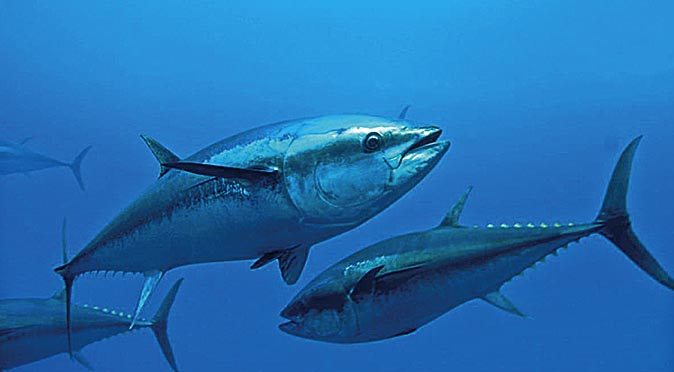Tuna-netting vessels by 2020

For the first time, Bangladesh is preparing to fish in international waters. The Department of Fisheries has allowed 16 fishing firms to fish through ‘Long-Lining’ and `Purse Seining’ technique beyond the depth of 200 meters of the Bay of Bengal and open area of the Indian Ocean. These firms will catch `Tuna’ fish one of the most valuable sea foods in the world market, and other pelagic fishes. Some of the companies will start fishing in the extreme last part of Exclusive Economic Zone of Bay of Bengal, and adjoining Indian Ocean by 2020.
Authorities and stakeholders said, the plan is most dynamic and also an upbeat attempt to promote Blue- Economy. Now Bangladeshi vessels have the ability to fish only in the maximum depth of 200 meters of the Bay of Bengal, The area is only 32,440 Sq Km whereas the country's sea territory is 118,813 Sq Km. Rest of the two-thirds of economic zone and next is the international open area of the Indian Ocean, where there is fishery field of very valuable Tuna and other giant fish species.
For years, neighbouring India, Sri Lanka and the Maldives have been fishing in the international open area. After the settlement of maritime boundary dispute, in 2013-14, the government has taken an initiative to send Bangladeshi fishing vessels to deeper area of its sea territory in the Bay of Bengal and international area of the Indian Ocean.
Mohammad Abul Hasnat, Director of Marine Fisheries Directorate MFD said that 16 fishing firms, including a concern of Bangladesh Navy have now been allowed to catch fish in the high sea. Of them, nine firms are permitted 'Long-Lining' and seven, through `Purse Seining’ technique.
“In our exclusive economic zone in the Bay of Bengal, there is possibility of having `Yellow Fin’ and ‘Skip Jack’ species of Tuna class. Hopefully, vessels of allowed firms may catch Tuna by the year 2020, he added. Tuna variety of fish is one-third of the world's marine fisheries exports. The Indian Ocean is believed to have 20 percent of the world's Tuna stock.
According to MFD, Bangladesh was recently awarded membership by the Indian Ocean Tuna Commission, IOTA, affiliated by food agency of the United Nations. After getting this membership, Bangladesh is eligible to catch tuna and tuna-like species from the Bay of Bengal and coast, to deep in the Indian Ocean.
There are currently no estimates as to potential tuna catches in the Bay, since it is the first-ever such initiative to be deployed by the country.Mohammad Shahjalal, Managing Director of Blue Harbor Fisheries Ltd an enterprise which has license for Tuna fishing told Bangladesh Post, “Bangladeshi fishermen catch a very small amount of Tuna in winter, thus proving its availability in our territory. Besides this, Sri Lankan fishermen also catch a remarkable amount of Tuna in our adjoining areas of the Bay of Bengal and Indian Ocean.”
“Tuna fishing in the area with the appropriate technology and vessels is more likely to be beneficial, but its needs more efforts as we Bangladeshi firms are not experienced to fishing such high seas.” He added. Mohammad Shahjala also said. “Since ensuring sea territory, Tuna catch is encouraging, but it will have to be taken up as a project of financial support with soft loans of less interest and technical support to entrepreneurs, by the government.
Cost of a new ship for Tuna fishing with modern technology is around Tk 80-100 core. But government may allow buying 15- 20 years old reconditioned vessels as an early move.”
MFD source said, a small amount of `Mackerel’ or Tuna family like `Eastern Little Tuna’ locally known as `Bom Maittya’, ‘Long Tail Tuna’ locally know as `Kawua’ and `Bullet Tuna’ locally known as ‘Bullet’ are been found in the Bay of Bengal. Of these only ‘Eastern little Tuna’ average weight of 4-5 Kg is more valuable than others in the local markets of greater Chattogram region. Sometimes `Yellow Fin’ and ‘Skip Jack’ Tuna of 20-30Kg has been caught by fishermen in 200 meters depth areas in the Bay of Bengal.
Mohammad Shahjalal said this was a sign of having Tuna in our area. 500 meters and deeper area of sea is ground of giant Tuna of 40-70 Kg. The subject is that we should go there to get them. Due to the excessive demand of tuna fish in the international market, various organizations including the United Nations are keeping an eye on the accumulation of this fish. Bangladesh is included as a pilot country of the Blue-Economy which is considered a key factor to achieve UN-declared 'Sustainable Development Goals'.
The fishery ground has not expanded for many years, but every year fishermen and fishing vessels are increasing. The research ship MV Meen Shandhani has been operating in the
sea for collecting information and data on new fisheries grounds in the Bay of Bengal. But the ship is not in survey of Tuna. “Tuna factor is different, and another survey is needed on Tuna fish of Bay of Bengal so that our entrepreneurs can move in high sea without hesitation, said Prof Sayedur Rahaman Chowdhury of the Marine Science Institute of Chattogram University. Bangladesh is the third largest fish producing country in the world, with an annual production of about 38 lakh tonnes. Of these, 17 percent is collected from the sea. Fisheries extraction of the country from the Bay of Bengal was 6.54 lakh tonnes in 2017-18.





